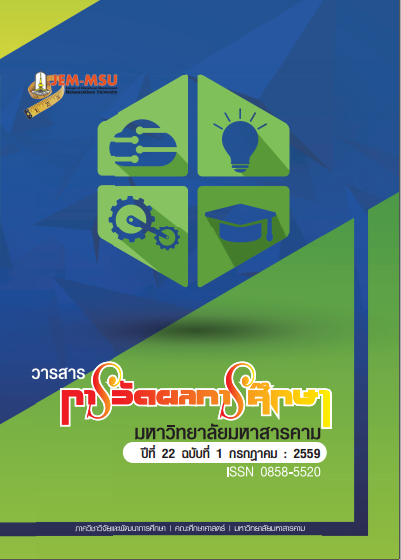Factors Affecting Decision Making on Continuing One’s Education in Private Vocational Schools in Southern Isan
Main Article Content
Abstract
Vocational education is an important mechanism in the production of high level
manpower that people in general can choose to continue their education. Factors in private
vocational educational institutions, however, are needed to be known before one makes a
decision to enter. The research aimed to study the factors that affect decision making on
continuing one’s education in a private vocational school in Southern Isan and study the
relationship among the factors that affect decision making on continuing one’s education in
a private vocational school in Southern Isan, and to formulate a prediction equation to
predict the factors that affect decision making on continuing one’s education in a private
vocational school in Southern Isan. The sample comprised 378 first year students from 6
vocational schools in the academic year 2014, obtained through Multi-Stage sampling.
The instrument was a 5-level rating scale questionnaire containing 72 questions, with the
discrimination power ranging from 0.41 to 0.78 and the total reliability of 0.86 The statistics
employed in the analysis of data were percentage, mean, standard deviation, Pearson
Product Moment Correlation Coefficient and Stepwise Multiple Regression Analysis.
The results are as follows:
1. The factors that affect decision making on continuing one’s education in a
private vocational school in Southern Isan, on the whole, were in the high to highest levels.
2. The correlation coefficient between each predictor and criteria revealed that
most predictors were related to the criteria with statistical significance at the .01 level. The
predictor with the highest relationship with the criteria was the vocational school curriculum
which had the correlation coefficient of 0.425. Meanwhile, the predictor with the lowest
relationship with the criteria was the fee and source of investment funds of the vocational
school which had the correlation coefficient of 0.197.
3. The vocational school curriculum factor, the vocational school surrounding
factor, the factor of external influence relating to choosing a vocational school, the factor of
student recruitment system, and the factor of fee and source of investment funds of the
vocational school, together predicted the decision making on continuing one’s education in
a private vocational school in Southern Isan at 46.20 percent. The standard error of
prediction was .19782, and the equation with raw score could be derived as follows :
The predictive equations raw score
Y = 1.259+ .169(X4)+ .147(X6)+ .167(X2) + .159(X3)+.039(X7)
The predictive equations in standard score
Z = .467(X4)+ .263(Z6)+ .302(Z2)+.264(Z3)+.102(Z7)
In conclusion, the vocational school surrounding factor, the factor of external
influence relating to choosing a vocational school, the factor of student recruitment system,
and the factor of fee and source of investment funds of the vocational school had a positive
relationship with the decision making on continuing one’s education in a private vocational
school in Southern Isan. Therefore, the administrator needs to use these factors seriously to
obtain concrete results from practice, give the factors importance to make them guidelines
for schools and organizations related to education in planning for student recruitment and
setting policies, taking into account the correct priority of the factors.
Article Details
The content and information contained in the published article in the Journal of Educational Measurement Mahasarakham University represent the opinions and responsibilities of the authors directly. The editorial board of the journal is not necessarily in agreement with or responsible for any of the content.
The articles, data, content, images, etc. that have been published in the Journal of Educational Measurement Mahasarakham University are copyrighted by the journal. If any individual or organization wishes to reproduce or perform any actions involving the entirety or any part of the content, they must obtain written permission from the Journal of Educational Measurement Mahasarakham University.


